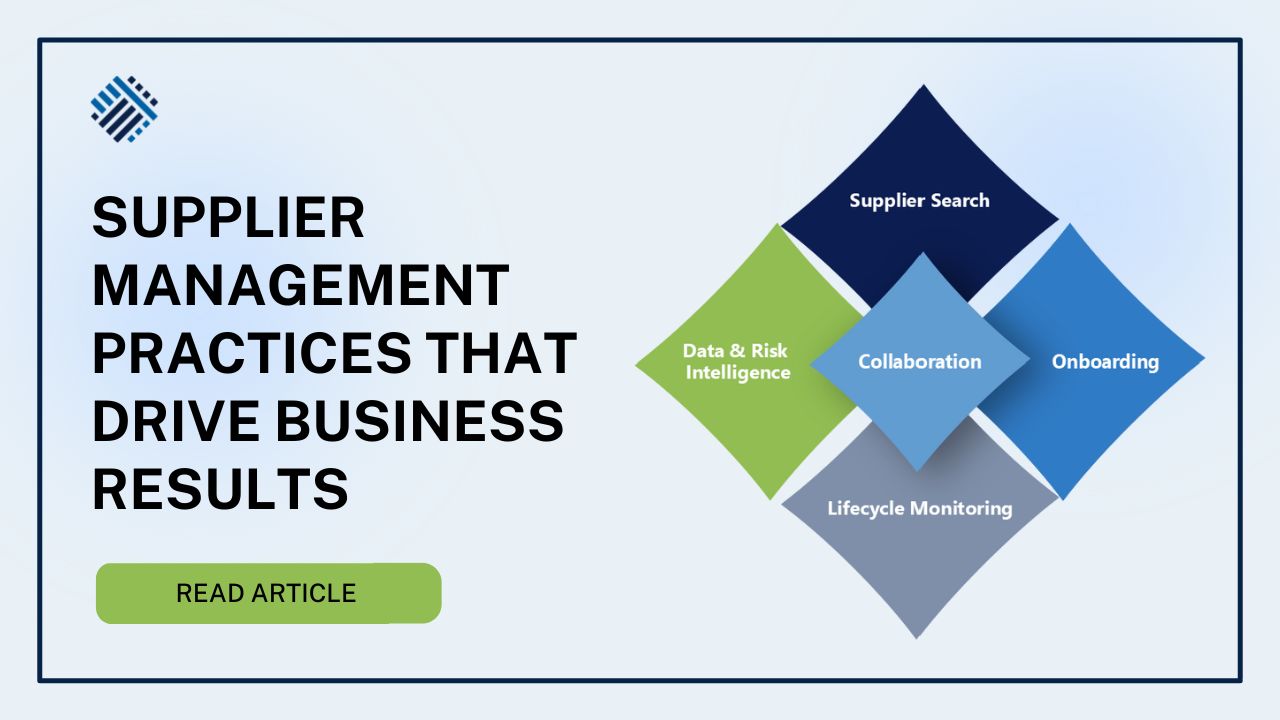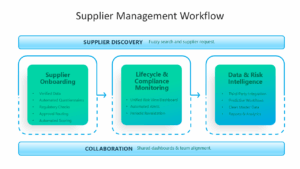Good Supplier Management Practices That Drive Business Results

Managing suppliers effectively is not just about onboarding them and hoping for the best. When supplier management is inconsistent or siloed, organizations risk inefficiencies, compliance gaps, and even fraud. Companies that implement structured, intelligent supplier management practices see measurable improvements in procurement efficiency, risk mitigation, and operational resilience.
Modern supplier management is about more than software. It is about good practices backed by data, automation, and visibility. Here is how organizations can drive business results with proven supplier management practices and how tools like Trust Your Supplier (TYS) help make them scalable and sustainable.
Standardize Your Supplier Onboarding Process
A consistent onboarding process reduces errors, speeds approvals, and ensures suppliers meet regulatory requirements from day one. Standardization does not mean rigidity. It means having clear expectations, repeatable workflows, and a reliable way to evaluate every supplier.
Questionnaires play a critical role here. TYS offers:
- Standardized questionnaires developed with a consortium of major buying organizations. These are updated regularly to reflect evolving regulations so suppliers answer only what is necessary while your team captures all critical compliance information
- Custom questionnaires tailored to unique organizational or regional requirements, ensuring your compliance needs are fully addressed
- Questionnaire groups that bundle multiple assessments based on location, product, or service type, simplifying the process for suppliers and covering all relevant compliance areas efficiently
- Automated scoring and workflows where answers outside your internal risk thresholds are flagged automatically, allowing your team to focus on critical issues
- Predictive assignment rules, enabling your system to assign the right questionnaires to each supplier based on their profile, location, or category
- Internal due diligence checklists to manage steps beyond TYS, keeping teams aligned and synchronized during onboarding
With this approach, suppliers are evaluated consistently and efficiently, ensuring relationships start on a strong, compliant foundation.
Maintain a Supplier Lifecycle Monitoring Program
Supplier management does not stop at onboarding. Continuous monitoring ensures your supplier base remains healthy, compliant, and low-risk over time. Effective practices include:
- Unified Risk Views to see all supplier risks, including sanctions, ESG, cyber, fraud, and data privacy, from a single dashboard
- Modular risk blocks to select assessments by region, industry, or supplier type, focusing only on relevant risks
- Automated alerts to trigger immediate action when risk thresholds are crossed
- Team alignment where shared dashboards and workflows keep procurement, finance, and compliance teams in sync
Periodic revalidation is also critical. Just as routine dental checkups keep teeth healthy, refreshing supplier data ensures accurate financial credibility scores, valid certifications, and up-to-date compliance information. With TYS, you can:
- Schedule automatic revalidations based on supplier category, region, spend, or risk profile
- Trigger approval processes when key data changes
- Assign tasks to the appropriate team member for review
- Maintain clean, auditable master data, ensuring decisions are made on accurate information

Leverage Risk Intelligence and Third-Party Data
Good supplier management relies on trusted data. TYS integrates information from third-party providers such as Moody’s, D&B, and EcoVadis. This gives verified insights into supplier financial health, ESG performance, and regulatory compliance.
- Integrated dashboards provide multi-dimensional views, enabling deeper analysis of financial and ESG risks
- Dynamic alerts notify your team of changes, triggering re-evaluations automatically
- Predictive workflows assign questionnaires or compliance tasks based on third-party scores, ensuring you proactively address risks before they escalate
This combination of self-reported supplier data and authoritative third-party verification creates a single, reliable “golden record” for every supplier, reducing errors and supporting better decision-making.
Foster Collaboration Across Teams and Suppliers
Supplier management touches multiple departments, including procurement, finance, compliance, and operations. Collaborative workflows help teams stay aligned, reduce bottlenecks, and improve overall efficiency:
- Shared dashboards provide visibility for every team member
- Internal tasks and approvals are tracked and managed in the platform
- Suppliers can directly submit documents, answer questionnaires, and update information themselves, reducing back-and-forth emails
By centralizing these interactions, organizations maintain a clear audit trail and reduce manual effort while improving supplier engagement.
Streamline Supplier Discovery and Requests
Even with a healthy supplier base, new needs arise. Effective practices include:
- Maintaining a pool of trusted suppliers to act swiftly when sourcing new products or services
- Using structured search filters by location, industry, ESG rating, and financial stability
- Inviting suppliers efficiently and managing approval workflows within the system
For example, TYS allows procurement teams to perform a fuzzy search to find suppliers that meet complex criteria, such as a toothbrush provider in a specific region with high ESG scores and financial stability. This reduces sourcing times from months to days.
Case Study: Driving Real Results
One large life sciences enterprise with over 100 ERPs leveraged TYS to streamline supplier onboarding and manage approvals across decentralized teams. With integrated ESG and compliance monitoring, the organization achieved:
- Optimized due diligence aligned with German SCDDA regulatory standards
- Improved ESG monitoring and supplier sustainability adoption
- Streamlined audit and compliance management, reducing operational risk
- Full visibility into supplier performance and risk across multiple categories
This example demonstrates how structured practices, intelligent automation, and integrated data can transform supplier management into a strategic advantage.
Conclusion
Good supplier management practices such as standardized onboarding, lifecycle monitoring, risk intelligence, collaboration, and strategic sourcing, drive tangible business results. When paired with modern tools like TYS, these practices are scalable, efficient, and proactive.
Organizations that adopt these practices not only reduce risk and compliance issues but also improve procurement efficiency, supplier engagement, and operational resilience. Supplier management evolves from a transactional process into a strategic capability that supports growth and trust across the supply chain.
Explore how TYS Essentials can help your team implement these best practices efficiently. Schedule a demo or reach out to learn more.
